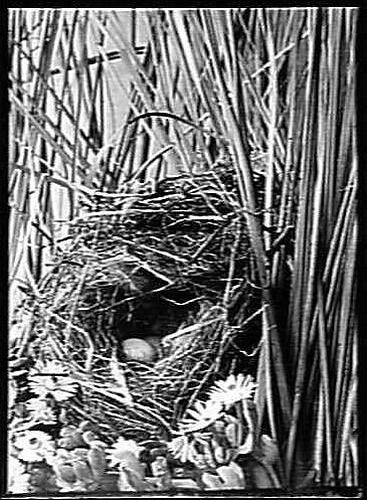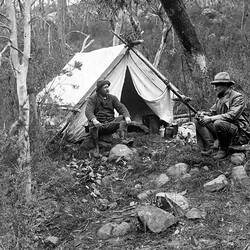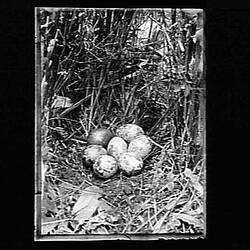STUBBLE QUAIL (Coturnix pectoralis, Gould - (486))
Geographical Distribution - Queensland, New South Wales and Victoria, South and Western Australia, and Tasmania.
Nest - Upon the ground in crop or herbage, the nesting hollow, 4-1/2 inches across, being lined with straw or grass as the case may be. (See illustration.)
Eggs - Clutch seven to eleven or twelve, rare instances maximum fourteen; roundish oval in shape; texture somewhat coarse; surface glossy; colour, dirty-yellow, heavily blotched and smudged with dark olive green. Dimensions in inches of a proper clutch; (1) 1.27 x .91, (2) 1.27 x .9, (3) 1.25 x .93, (4) 1.25 x .88, (5) 1.22 x .91, (6) 1.22 x .92, (7) 1.19 x .88. (Plate 17).
Observations - The Stubble Quail may be said to be the only true Quail in Australia. As its name implies, it frequents grassy or stubble-like localities on plain or in forest alike, and is found throughout Australia, except perhaps the extreme north, and Tasmania.
It is a fine bird, with its brown coat, the feathers being zig-zagged transversely with lines of black, and striped down the centre with spear l-like markings of yellowish-white. The chest and flanks are brown, while the abdomen is whitish; feet also whitish, dark, and eyes hazel. Total length about 6-3/4 inches; bill, ½ inch wing, 3/7/8 inches; tarsus, 7/8 inch. The male is readily distinguished from the female by the black markings on his chest and his buff-coloured throat, the throat of the female being white. Two brace of both sexes presented to me by a friend at the opening of last season weighed 15 ounces total.
During his rambles in Australia, Gould frequently found nests and eggs of this Quail, remarking that 'the number of eggs in each nest varies from eleven to fourteen. The situations chosen for the nest are much diversified; sometimes it is placed among the thick grass off luxuriant flats, while at others it is artfully concealed by a tuft of herbage on the open plains.'
I possess pleasant recollections of my first experiences amongst the Stubble Quail, when long ago, as boys, we used to find their eggs in the crops on the plain, or under rank tussock grass that clothed the banks of the Werribee River. So plentiful were they one season that we captured some of the birds themselves, not to mention maimed birds that had survived the shot of the fowler and escaped his dogs.
Mr. C.H. Grove, Snowy River, Gippsland, sent me the following interesting note, together with the clutch of seven Stubble Quail's eggs:- 'Bird commenced to lay 30th November (1891) and laid for seven consecutive days, the smallest egg (a brownish-coloured example) being the last. The nest on the first day was a bare hole scrapped in the ground, but after the eggs were all laid some slight attempt was made at lining it.'
In Southern Victoria, before the Quails were disseminated or distributed, "Old Bushman" (the late H.W. Wheelwright), in his fascinating little volume, 'Bush Wanderings of a Naturalist', remarks that he observed the Stubble Quail come down about the middle of September, and remain to breed, and early in February they all appeared to leave the breeding grounds, but not the district, for they them packed, and in certain localities large flocks were to be seen late in March. The call-note of the Stubble Quail is a loud, oft-repeated 'to-weep', the native name of the bird. Their note as they rise is a sharp chirp. Sportsmen regard the bird as easy to kill on account of its straight flight. Some of the earlier birds breed in September, others later, according to the season, the majority laying in the summer months (i.e., December, January, and February), or when the seeds ripen. We have many instances of late (probably second) broods in Victoria.
I knew of an incident at Mordialloc, on the opening day of the shooting season for Quail (1st March, 1897), when a Stubble bird rose and was shot, it being afterwards ascertained she flushed from a set of six fresh eggs. The same season, in Gippsland, at mid-winter (July), a clutch of newly-hatched young was seen.
Captain Doveton, a keen sportsman, kindly furnished me with a note of having seen, at Sunbury, on 28th April, 1888, Stubble Quail too young to shoot.
My friend Mr. A.W. Milligan, in communicating to The Australasian, and writing from Gippsland, the season 1895, states:- 'It might be interesting to some of your sporting and scientific readers to know that on Good Friday morning last, 12th April, whilst Quail shooting on the Traralgon Park Estate, Traralgon, I found a Quail's nest containing seven eggs. On breaking one of them I found it to have been comparatively new-laid. On Easter Tuesday following, the dogs of my friend who accompanied me flushed a 'squeaker,' which I subsequently caught, and have now in captivity.The dogs on the same day found three much younger birds, which were unable to fly, one of which they killed. The birds were the Coturnix pectoralis, or Stubble Quail.'
I could recount many other instances of Quails breeding laet in the season, were it necessary.
There has been much controversy in Victoria, about the close season for Quails, many of our sportsmen complaining that it opens too late (i.e., 1st March); but I think it would be to the sportsman's own interest to let the law remain as it is, besides, it would give the birds the benefit of the doubt. Our Quail are not migratory, as some persons suppose, but their movements are regulated by the seasons. If they were migratory, they would disappear from Tasmania also, where, if I remember rightly, the shooting season does not open till the 1st May.
A fact that mitigates against our brooding Quails is that they are prone to nest in grain crops, which are usually garnered before the young are hatched; thus many eggs are destroyed. Then if the old birds seek other pastures they have hardly time to rear second broods before the hunter's gun is heard. I may here give the interesting and valuable remarks of 'Neno,' as they appeared in The Australasian, 5th December, 1896 :- 'The common belief is that Stubble Quail migrate, arriving in Victoria in spring, and leaving in autumn. Such a belief is erroneous. Quail do not migrate. They certainly shift about, and at odd times, owing to bad seasons, they move off to better feeding grounds. In spring the stubble birds are numerous on the grassy river flats and reclaimed coast marsh lands of South Gippsland, also in growing crops, and such like places. Young Quail may be seen in November, and I have noted them up to the end of February. When the shooting season opens in March many birds are shot on the flats and stubble fields, but during April and May sportsmen find that they are getting scarce in such places, and nine out of ten shooters will tell you that the birds are migrating. Not so; they have only gone to better feeding grounds, and will not be far off. The great wastes of barren bayonet or spear grass plains are the winter home of the Stubble Quail. The birds feed on the rich sunflower-like seed of the spear-grass. There are miles of spear-grass plains in South Gippsland, stretching from the mouth of Powlett River round to Foster In winter Quail are to be found wherever the spear-grass is in seed. The rat-tail-shaped seed pods are known locally as black-heads. Shooting over these plains I kill mostly stubble birds in the open, an d Brown Quail on the edges of patches of stunted tea-tree. On the dry ridges I get an occasional brace of Painted birds. The plains simply swarm with the little King Quail. The best shooting is to be had in June and July. In March a good shot should account for every bird rising in range, for, as a rule, they are mostly squeakers, but on the open spear grass plains on a chilly winter's day, with a stiff breeze blowing, the fine full-conditioned Stubble or Brown Birds get away with strength and speed, that will test the skill of the most expert. During last winter (1896) Quail were exceptionally plentiful on the Powlett Plains, and at Cape Patterson, but the market shooters swept over the country, and cleaned them out to a bird. There were hundreds of brace shot round about the village of Inverloch alone. The marketer uses the best nitro powders, and I have seen one tramping behind eight setters, working regularly day after day, and killing out every bird, often shooting as many as thirty brace in a day. When a marketer camps on a shooting ground he appears to consider that he is sole owner of the game, and manfully disputes the right of anyone else to shoot. I need scarcely say that he is not much loved by the sporting Quail shooter. When shooting in winter on the plains I have noticed the absence of Hawks. One would naturally expect to find them where game is so plentiful, yet we rarely see anything but an occasional Eagle. I often shoot specimens of the domestic cat gone wild, foxes and native cats on the Quail grounds; and I think the fox is the greatest enemy they have.'
Young in down resemble miniature chicks of a domestic fowl, being brownish in colour, indistinctly striated with black.
Resources
Transcribed Archibald James Campbell. Nests and Eggs of Australian Birds, including the Geographical Distribution of the Species and Popular Observations Thereon, Pawson & Brailsford, Sheffield, England, 1900, pp. 721-724.
More Information
-
Keywords
-
Authors
-
Contributors
-
Article types


